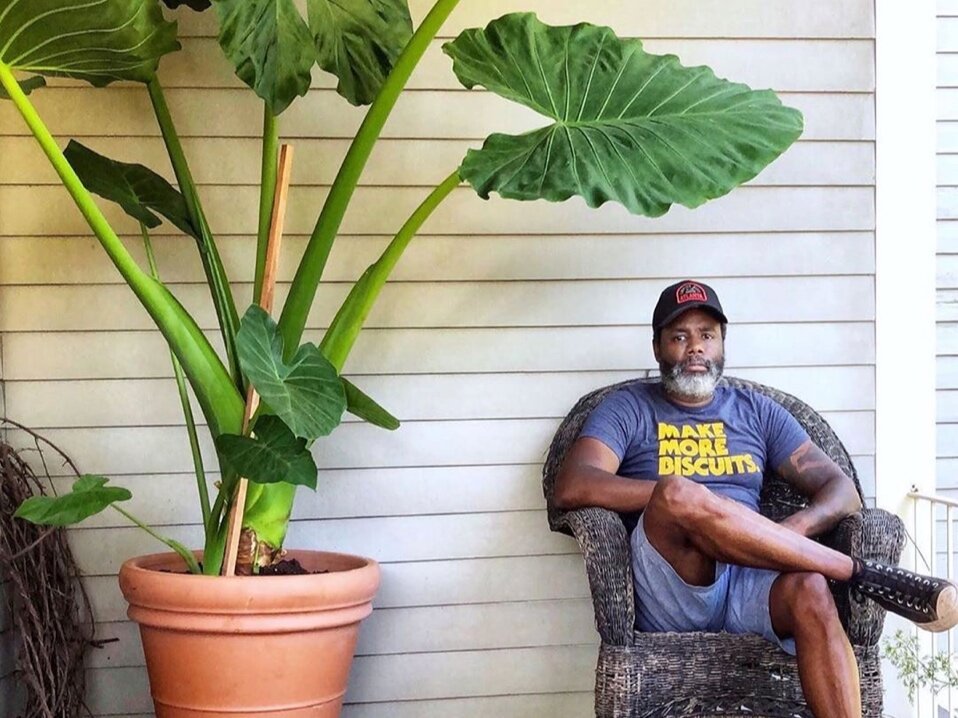A Georgia journalist reflects on covering the coronavirus pandemic and the solace he finds in planting sunflowers.
by Jeremy Redmon
Crawling on my hands and knees, I planted dozens of mammoth sunflowers along the edge of my north Georgia backyard in early March, gently pushing the seeds into the cool, red clay. I wanted to watch them bloom. I wanted to roast their seeds and sprinkle them on the salads I make for my family with the lettuce, cucumbers, and heirloom tomatoes from our garden. I wanted my son and daughter to learn how to grow their own food. Secretly, I hoped the bright yellow flowers would lift the spirits of my neighbors in Woodstock. Among them is the friendly man who lives behind us. Suffering from dementia, his elderly father sometimes did not recognize him before dying recently.
I have experience raising vegetables, fruit, and herbs, a passion inspired by my late grandparents, enthusiastic gardeners from Paris, Kentucky, and Sacramento, California. But I knew little about sunflowers and how easy they are to grow. So I cheated, sprinkling the seeds with store-bought soil. They shot up Jack-and-the-Beanstalk-style, some topping nine feet with stems as thick as broomsticks. I did not foresee it when I planted them, but I would need them as I began reporting on the coronavirus outbreak for The Atlanta Journal-Constitution.
I took breaks from writing about the pandemic to gaze at the plants. I watched as tiny ants crawled along their hairy stems and as morning dew dripped from their sandpapery leaves. I could sense the tension in the buds preparing to spiral open. Eventually, I spotted something I had never noticed before. From east to west, their dinner plate-size tops shifted throughout the day to face the sun. Called solar tracking, this movement is guided by the plants’ circadian rhythm. There is a parallel with journalists. We steadily fix our gaze on trauma — wars, natural disasters, pandemics. We bear witness to these events so we can prove to our readers they are true.
Soon after planting my sunflowers, I joined fellow journalists in scrambling to report on COVID-19 as many Americans shrugged at it, falsely claimed it was no worse than the flu, or argued it was being exaggerated for political reasons. Frustrated by this denial, my colleagues and I raced to detail the devastation, to get as close as possible to the victims and vividly write about their misery. The famous war photographer Robert Capa has been quoted as saying: “If your pictures aren’t good enough, you’re not close enough.” The same is true about writing.
I am fortunate. My wife and I are white and remain employed, while millions of other Americans have lost their jobs amid a pandemic that is disproportionately afflicting Black and Hispanic people. We are also healthy, though sometimes I wear myself down reporting on the outbreak to the point where I feel hollow. I struggle to sleep after wrestling with confusing, stressful dreams. Short-tempered and racing on deadline, I bark at my wife and kids.
My sunflowers became my balm. When they were just inches tall, I stepped outside to stare at them as I wrote about an Afghanistan war veteran’s harrowing battle with COVID-19 and his decision to isolate himself at Georgia’s remote quarantine site near Rutledge. I gazed at my sunflowers after writing about one of the first people in Georgia to die from COVID-19, a 65-year-old grandmother from Rome who wrote a book about the wisdom she found in gardening. I listened intently as her daughter told me about her family’s decision to remove her from life support. I studied my sunflowers after another woman from north Georgia described for me her final moments with her husband, a former hospital lab technician who died from the coronavirus disease. She kissed his hands, reminisced about their wedding day, and reassured him she would be OK after he was gone. I visited my sunflowers as I wrote about COVID-19 ripping through Brunswick and West Point, Ga., forcing cruise ship passengers into quarantine at a military base in Marietta and infecting hundreds of nursing home patients and poultry plant workers across the state.
At a point called anthesis, sunflowers bloom and stop tracking the sun. They permanently fix their gaze eastward as they reach the end of their lives, or as William Blake wrote in “Ah! Sun-flower”: When they become “weary of time” and seek the “sweet golden clime/ Where the travellers journey is done.” I wonder what will happen when my colleagues and I retire from daily journalism. I wonder if we will fix our gaze in one direction, if we will stop tracking trauma, if we can stop tracking it.
Donning my mask, I visited a church in Cartersville, Ga., where a major outbreak of COVID-19 infected as many as 100 worshipers and killed at least four. The Church at Liberty Square had finally reopened its sanctuary for Sunday services after shutting down for weeks amid the pandemic. When I arrived to report on the reopening, I saw parishioners refraining from shaking hands or hugging. They filed into the sanctuary in stages. Once inside, they sat apart. Clergy led the predominantly white church in praying against two plagues simultaneously afflicting America, the pandemic and racism. The church had reopened amid the nationwide protests following the killings of Black people in Minnesota, Kentucky, and Georgia: George Floyd, Breonna Taylor, and Ahmaud Arbery. When I returned home that day, I immediately hugged my family. Then I stepped into my backyard. The sun slid westward. My sunflowers tilted the same way. The contours of the story about the church’s reopening took shape in my imagination. On deadline, I began to write.
As the summer heated up in Atlanta, as the protests persisted, and as the numbers of new COVID-19 cases surged in Georgia and across the South, my sunflowers faded and drooped, shedding their petals. I snipped off their heads, thumbed out their seeds, soaked them in brine, and roasted them. The seeds – vessels of the serenity I’ve found raising sunflowers amid the pandemic – now nourish my family. I have more reporting to do as the disease stubbornly rages on. So, returning to my hands and knees, I planted more mammoth sunflowers along the edge of my backyard in north Georgia, gently pushing the seeds into the cool, red clay.
Update, August 21, 2020: The last sentence of the first paragraph was changed after the writer learned that his neighbor’s father had passed just before publication of this story.
Jeremy Redmon writes for The Atlanta Journal-Constitution. He graduated in 2019 from the University of Georgia’s Master of Fine Arts program in narrative nonfiction writing. Follow him on Twitter at @JeremyLRedmon





